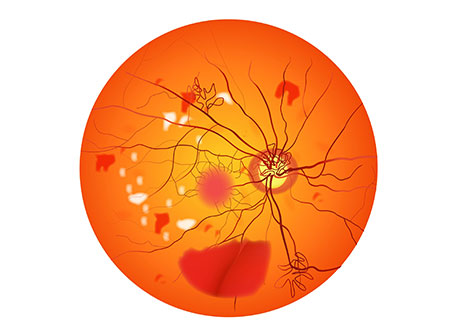Diabetic Retinopathy
published on: 15th march, 2023
Dr. Noura Almansoori is a Consultant Ophthalmologist who have gained her Bachelor of Medicine and Surgery degree in United Arab Emirates University back in 2010. To further her studies, she has worked for an Internship in Tawam Hospital; then, went for Toronto University-Canada under Dr. W. Ching Lam and Dr. J. Christakis. She also has been a Resident Ophthalmologist in Sheikh Khalifa medical Center and a PGY3 Chief Resident. She is notable for her acceptance on one of the research posts in Vitreo-Retinal Surgery of the Ophthalmology Department of Mayo Clinic in the United States of America and continued her clinical fellowship in Vitreo-retinal Surgery in the University of Montreal in Canada. She is currently the Deputy Medical Director of Samaya Specialized Center.
What is Diabetic Retinopathy?
Diabetic Retinopathy is the leading cause of visual impairment among people of working age and has social consequences beyond sight loss. It has been also noted as the most frequent cause of blindness among adults aged 20 to 74 years old. Molecular and physiologic abnormalities found to develop in the retina for individuals with diabetes are consistent with inflammation.
Why is Diabetes linked to Retinopathy?
As of the worldwide statistics, diabetes mellitus affects 200 million people worldwide. As lifelong progressive disease and as result of the body's inability to produce insulin or use insulin through its full potential-characterized by high circulation glucose, diabetic retinopathy remained to be difficult to prevent and treat. As retinopathy involves all the major cell types of the retina and the same systemic cardiovascular risk factors which increases the risk of stroke, myocardial infarction, and renal failure.
What are the symptoms of Diabetic Retinopathy?
- Black spots or floaters in the field of vision.
- Cataract which is more common for diabetic patients.
- Reduced night vision.
- Patches or streaks due.
- Sudden vision loss due to large bleeds or hemorrhage.
- Retinal detachment/ Diabetic macular edema
What are the management options for Diabetic Retinopathy?
- LASER to seal leaking vessels, to decrease or prevent swelling and to improve blood circulation of the healthy retina.
- intraocular injection to help sealing leaking vessels to improve and preserve the retina.
- Surgery or Vitrectomy to restore the retina's condition.
- Cataract surgery for removal of cataract and intraocular lens.
References
- Porta, M., & Bandello, F. (2002). Diabetic retinopathy, Diabetologia, 45(12), 1617-1634.
- Fong, D. S., Aiello, L., Gardner, T. W., King, G.L Blankeship, G., Cavallerano, J. D., ... & Klein, R. (2004) Retinopathy in diabetes. Diabetes care, 27(sppl 1), s84-s87.
- Ferris, F. L. (1993). How effective are treatments for diabetic retinopathy? Jama, 269(10), 1290-1291.
- Tang, J., & Kern, T. S. (2011). Inflammation in diabetic retinopathy. Progress in retinal and eye research, 30(5), 343-358.
- Mohamed, Q., Gillies, M. C., & Wong, T. Y. (2007) Management of Diabetic Retinopathy. JAMA, 298(8), 902. doi:10.1001/jama.298.8.902
- Kowlr, R. A., & Chan, P. S (2007). Oxidative stress and diabetic retinopathy. Experimental diabetes research, 2007.
- Gardner, T. W., Antoneeti, D. A., Barber, A. J., La Noe, K. F., Levision, S. W., & Penn State Retina Research Group. (2002). Diabetic retinopathy: more than meets the eye. Survey of ophthalmology, 47, S253-S262.
Did You Know?
Most important factor in medical management of diabetic retinopathy is good glycemic control, which is associated with reduced risk of newly diagnosed retinopathy and of progression of existing retinopathy.
recent posts
- Understanding Blepharitis: Causes, Symptoms, and Treatment Options
- The Role of Technology in Cataract Surgery: Abu Dhabi's Latest Techniques
- Understanding Keratoconus: Causes, Symptoms, and Diagnosis in Abu Dhabi
- Clearing the Fog: Understanding Glaucoma's Silent Threat to Vision
- Battling the Eye's Bumps: All You Need to Know About Pinguecula
- Understanding Pinguecula: Causes, Symptoms, and Management
- What Should I Consider When Choosing the Best Eye Hospital in Abu Dhabi?
- What is Diabetic Retinopathy?
- What is Glaucoma?
- Eye Squint (Strabismus)
- Keratoconus
- Cataract
- Dry Eyes Syndrome
- Chalazion
2024. All Rights Reserved Samaya Specialized Center
